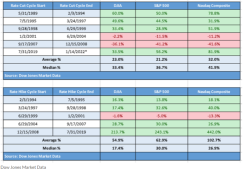By Scott Bauer, for CME Group
AT A GLANCE
- The start of Fed hiking cycles tends to coincide with a strong economy which can help to lift cyclical sectors such as materials, industrials and energy
- The S&P 500, Dow Jones and Nasdaq composite have overall positive returns during Fed rate hike cycles dating back to 1989
Why Does the Stock Market Care?
First, let’s analyze how stocks historically perform when interest rates rise. Do interest rate increases usually translate into a weaker stock market? Historically, when rates increase it's actually good for stocks overall. The S&P 500 has been resilient around the start of Fed hiking cycles in the past. In fact, according to Dow Jones, since 1989 during a Fed rate-hike period the average return for the Dow Jones Industrial Average is nearly 55%, that of the S&P 500 is a gain of 62.9% and the Nasdaq Composite has averaged a positive return of 102.7%. Keep in mind that these numbers may be inflated due to the outsized gains from December 2008 through July 2019.
As a rule, the market cares for a couple of reasons. One is the potential slowdown of the U.S. economy and the other is the prospect of other investments like bonds becoming more attractive relative to stocks. The implications are that rates are going up to slow (not stop) the rate of economic growth. A strong economy can be very good for companies, but a tightening of monetary policy will put pressure on economic activity.
So how may investors navigate the impending rising rate environment? Historically, highly profitable, well-capitalized firms perform best when financial conditions tighten. The start of Fed hiking cycles tends to coincide with a strong economy which can help to lift cyclical sectors such as materials, industrials and energy. Financial stocks typically outperform as well. According to Goldman Sachs, strong balance sheet stocks have outperformed weak balance sheet stocks by a whopping 24% during a Fed hiking cycle.
If rates rise, investors may see more value in bonds, certificates of deposit and other assets thought to be less risky than stocks. However, history paints a different picture.
Read more articles like this at OpenMarkets






